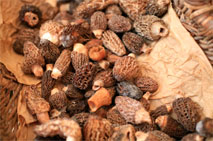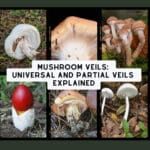Few people are indecisive about edible mushrooms. They either love them or hate them. Yet these fleshy fruiting bodies of various species of fungi have a lot to offer to both your meal and your body.
What makes a mushroom edible? Edibility is defined as the absence of poisons and the presence of a desirable taste and smell. So it’s not enough that a certain mushroom won’t make you sick, it has to taste good as well! (Although we all know that taste is, well, a matter of taste.) Very few species meet these criteria, thus most mushrooms are considered inedible.
The practice of eating mushrooms dates back thousands of years. The first reliable evidence appears with the Chinese, and continues through time to today, spanning many different cultures.

From cultivated white buttons to elusive morels and truffles, edible mushrooms continue to be popular the world over. I’ve included much more information below, starting with important things to know. This covers both health benefits and dangers. We’ll then move on to cultivated vs. wild mushrooms, and end with how to prepare. Guaranteed to make you hungry!
Important Things to Know
Edible mushrooms have uses beyond jazzing up your favorite recipe. They’re known for their health benefits as well. Besides being low in sodium, fat, and calories, most mushrooms contain:
- Fiber
- Potassium
- Protein
- Selenium (an important antioxidant)
- L-ergothioneine (another powerful antioxidant)
- Copper (needed for cardiovascular health)
- Niacin (an important B vitamin)
- Cancer-fighting ingredients (polysaccharides, linoleic acid)
- Zinc
Of course, your mileage may vary depending on the type of mushroom and the environment in which it grew. To reap the greatest health benefits, it’s best to consume mushrooms that were grown organically, or that were picked from a non-toxic environment. For more about the nutritional value of mushrooms, see this page.
Considering poor environments brings us to the downsides, the possible dangers. These dangers include man-made toxins, poisonous mushrooms, consumption with alcohol, and allergic reactions.
- Man-made toxins, such as mercury or pesticides, become concentrated as the organism absorbs nutrients from its environment. Never eat mushrooms from polluted areas.
- Certain poisonous mushrooms can cause illness or death. If you’re picking specimens from the wild, always make a positive identification before eating it.
- Alcohol interacts badly with a few species, such as Coprinopsis atramentaria. Take care if eating a lot of mushrooms and drinking.
- They say that everyone’s allergic to something, and there are cases of mushroom allergies. Only have a small amount as a test if you’re eating a new mushroom for the first time.
Avoid problems by educating yourself about what you’re eating.
Different Types of Edible Mushrooms
Edible mushrooms are either commercially cultivated or picked from the wild. You can also try cultivating them at home on a small scale. (It’s a fun project!)
Commercially cultivated mushrooms are produced on farms and growing sites all over the world. Below is a list of some common species that go from growing room to grocery store. Click on the links for more information:
- White buttons – Agaricus bisporus – The common white button-shaped mushroom in stores.
- Cremini – Agaricus bisporus – Slightly larger, brown strain of the white button. Known for its firm texture and heartier taste.
- Portobello – Agaricus bisporus (yet again!) – Simply a large, overgrown cremini. Popular on their own and as a meat substitute.
- Oyster – Pleurotus ostreatus – One of the easiest species to cultivate, produced all over the world.
- Enokitake – Flammulina velutipes – These long and thin mushrooms are popular in soups.
- Shiitake – Lentinula edodes – These well-known mushrooms are delicious and good for you.
Wild mushrooms are a little trickier. Certain species have a mycorrhizal relationship with specific tree and plants. The fungus invades the roots of the tree, giving it access to energy-giving sugars and giving the tree greater surface area to absorb water and nutrients.

This relationship is not easily simulated in a lab, making mycorrhizal fungi difficult to impossible to cultivate. For this reason they must be picked from the wild, and are much more expensive than commercially cultivated species.
There’s a huge industry around wild mushroom harvesting, one that’s sparked much debate. It’s not yet known what ecological impact removing so many mushrooms has on the environment. There’s also controversy over how migrant mushroom harvesters are treated.
So the next time you’re fortunate enough to be able to afford to purchase edible wild mushrooms, take the time to ponder where they came from, and who picked them for you!
Depending on where you live, you may be able to save yourself some money and any ethical crises by picking them yourself. This is not a task to be taken lightly, as a mistake can make you sick or worse. For more information see my introductory page on mushroom identification, and the page on common poisonous mushrooms.
Below is a list of some of the more popular wild edible mushrooms. Click on the links for more information:
- Morels – Morchella sp – Extremely popular the world over for their unique flavor and shape. Known to induce an intense appreciation!
- Maitake – Grifola frondosa – A strange-looking larger mushroom that is both edible and medicinal.
- Porcini – Boletus edulis – Another delicious edible loved the world over.
- Giant Puffball – Calvatia gigantea – Yes, these giant white globes are edible (and fun to look at).
- Chanterelles – Cantharellus cibarius – Considered a gourmet edible, these beautiful mushrooms are not difficult to identify with some practice.
- Matsutake – Tricholoma matsutake – These are very popular in Japanese cuisine.
- Shaggy Mane – Coprinus comatus – Should be eaten soon after cooking as they disintegrate into an inky mess.
- Black Trumpet – Craterellus cornucopioides – These rich-tasting mushrooms look like black chanterelles. My favorite edible species!
- Caesar’s Mushroom – Amanita caesarea – One of the few edible Amanitas. This stately mushroom is popular in Italy.
These lists are not the final word. There are more edible species out there to be enjoyed! (I’ll continue to add more in the future).
Final Preparation
Once you’ve acquired some edible mushrooms you’re faced with the big question, to wash or not to wash?

You’ll see all sorts of advice on whether or not to wash mushrooms before you eat them. The argument is that since mushrooms are mainly made up of water anyway, washing them may make them too wet and mushy. This disturbs the flavor and texture while cooking.
Others will advise that a quick rinse right before use isn’t bad, and that a bowl of salt water is also a good way to remove bugs from wild mushrooms.
My advice? Most mushrooms do not need to be washed. I usually just wipe them off with a damp cloth. Take it on a case-by-case basis, and if your personal edicts of hygiene are telling you to wash them then do it.
Everyone has different tastes, but here are some other rough guidelines for edible mushrooms:
- Don’t mix wild mushrooms with store-bought species. The flavor of the cultivated ones will over-run the wild ones.
- Take care when cooking wild species with other flavors. A strong flavor may overpower your mushrooms, rendering their inclusion in the meal pointless.
- If performing a saute, mushrooms should be cut into smaller pieces. (See this page on how to saute mushrooms for more information).
- Cooking mushrooms removes toxins and makes them more digestible. Never eat raw mushrooms.
- Research your mushroom before cooking, different species require different cooking instructions.
- Never eat a wild mushroom without having lots of experience identifying it.
- Remember that mushrooms are mainly water, and their volume will shrink significantly during the cooking process.
I’ve found a lot of people who say, “I don’t like mushrooms” often mean, “I don’t like the white mushrooms from the grocery store”. There are so many other types of edible mushrooms with so many different flavors!
If you don’t like one species, try another. Experiment and learn about all the delicious flavors that they bring to a meal. You’ll be glad you did!









Leave a Reply